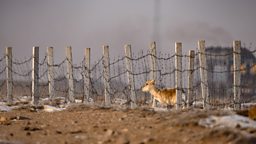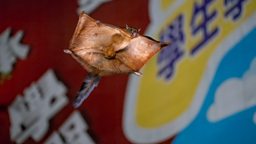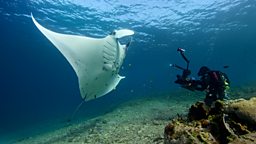Surrounded by snakes
By Luca Vaime, underwater cinematographer

In 2022, I was hired by the Â鶹ԼÅÄ Natural History Unit to go to the Banda Sea to capture a remarkable behaviour: sea snakes teaming up with trevally fish to hunt. I had previously heard about this phenomenon from a friend, who was one of the first to witness it.
Our search for sea snakes began here.
After some meetings with Producer Mark Wheeler, I set off for the volcanic island of Gunung Api with my assistant and safety diver, Otniel. Gunung Api is far from any other landmass, situated in the vast Banda Sea, where many areas are over 5,000 metres deep. Our search for sea snakes began here.
I was excited, we were the only people at Gunung Api, and the conditions were perfect. We started off by identifying hot-spots where sea snakes appeared to be congregating, hoping to see them teaming up with trevallies. The sea snakes were all around the island, swimming along the coral reef or looking for spots to nap, occasionally surfacing to breathe. The snakes were fairly easy to find and I was able to get ample coverage of their general day-to-day activities. It went on like this for the next few days. Every now and then, I caught a glimpse of the behaviour we were looking for, but it was never long enough to film.

Although I was capturing some great footage, I started to worry about the lack of cooperative hunting with trevallies. My biggest concern was the few trevallies I had seen on the reef. By day eight, we were halfway through our shoot, and I started to worry that we were in the rightplace, but at the wrong time. In wildlife filmmaking, there is a saying along the lines of “If there is action where you are, don’t leave for the unknown.” This was becoming a real dilemma. I had plenty of snakes to film, but they weren’t displaying the key behaviour we needed.
I could tell by the look in his eyes that he had found some action.
That evening, I voiced my feelings to the crew, and proposed the idea of leaving Gunung Api for Manuk Island. Manuk is another small volcanic island and a well-known sea snake hotspot - but it was far from over 220 nautical miles from our location – more than a day’s sailing away. The boat captain advised that if we went to Manuk, there was no going back to Gunung Api. We had a big decision to make.
I dived early the next morning – again seeing plenty of snakes, but no action. On surfacing, I asked the captain to set sail for Manuk. I hoped it I would not soon regret this decision. To heighten the anxiety of having to make such a call, the weather had turned on us, leaving our boat at the mercy of the sea for the entire journey to the new destination.
We reached Manuk the following morning, and divided into two teams - one dive guide with me, while Otniel and another diver went to another location. About 30-40 minutes into my dive, I was surprised to see Otniel speeding toward me with a great deal of excitement in his face. I could tell by the look in his eyes that he had found some action. I surfaced and headed back to the boat to change batteries and memory card. The adrenaline was running high, but we needed to ensure that our equipment was safe and ready. Rushing things in these situations never works well, and increases the chances of something going wrong.
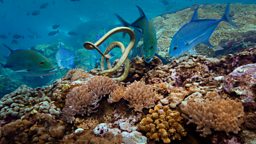
As we entered the water, there were 20 to 30 snakes with vast numbers of trevallies hunting in beautiful shallow water conditions. It was game on! Snakes were frantically swimming with the trevallies, all throwing themselves towards the coral head where their prey desperately tried to hide. It was hectic! As they kept changing sites, I swam for what seemed like miles back and forth to keep up with the action, trying to anticipate their next movements. It was challenging, but I was so relieved that we had finally found the action we were looking for.
I had sea snakes crawling up my legs and chest...
That evening, I messaged Mark via satellite about the behaviour we had filmed. We had been in touch every day, so he knew all about the emotional struggles and turmoil we had been through in making tough decisions. We continued to capture incredible hunting action over the remaining days.
Despite this success, we didn’t have all the footage we needed to complete the sequence – our discovery had come simply too late in the shoot. So, we returned again the following year. This time, success came much more rapidly. On our first day, I found myself underwater with hundreds of snakes and trevallies, all working together in an ordered mayhem of what would only seem like pure chaos to an outsider. I approached the action cautiously to ensure that my presence would not affect either species. Once I was sure that my I was not negatively affecting the action, I got as close as I could.
The snakes we encountered were at deeper depths, which increased the challenge. I recall the sound of the water swirling as fish and snakes thrashed along the reef pursuit of prey. Trying to be as steady as possible when filming became my greatest struggle - I had sea snakes crawling up my legs and chest, while others in front were busy hunting their prey. I was completely surrounded! I can’t really explain why I wasn’t bothered being surrounded by dozens of venomous snakes. Yet, if I see a small snake on land, every alarm in my body is going off telling me that I am in danger. It must be the blissful feeling of the ocean that calms my mind in such a situation.

...this sequence is down to the hard work and determination of all those involved.
Our second trip proved a significant step up from the year before, yielding invaluable insights and footage on this unique behaviour. I would like to extend my thanks to everyone who helped make this filming happen - this sequence is down to the hard work and determination of all those involved.
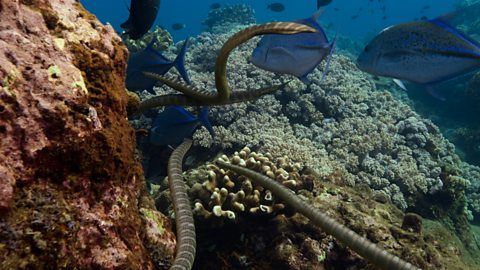
Sea snakes and trevally fish hunt as a team
Black-banded sea kraits and bluefin trevally join forces to hunt on the reef.


